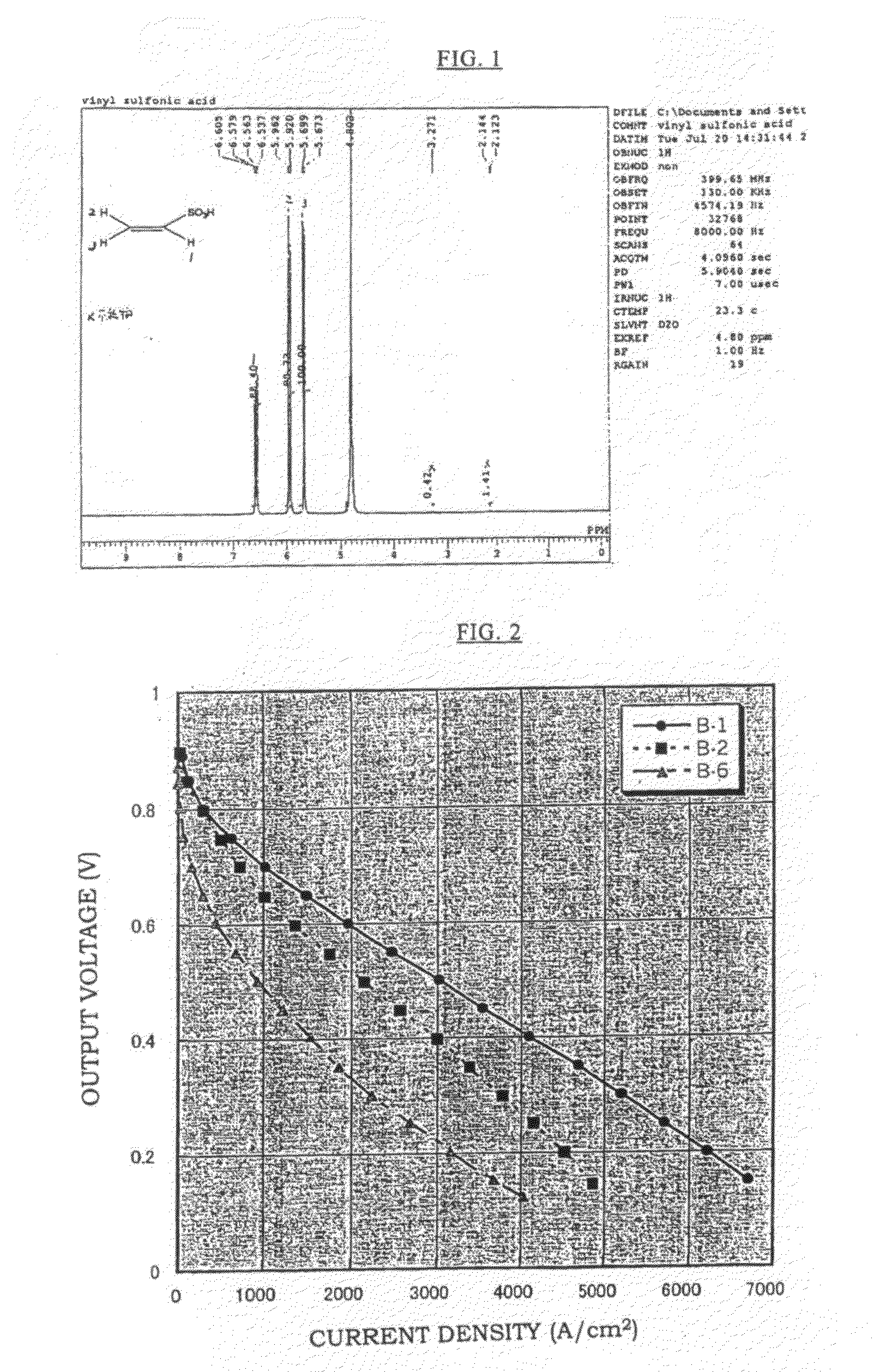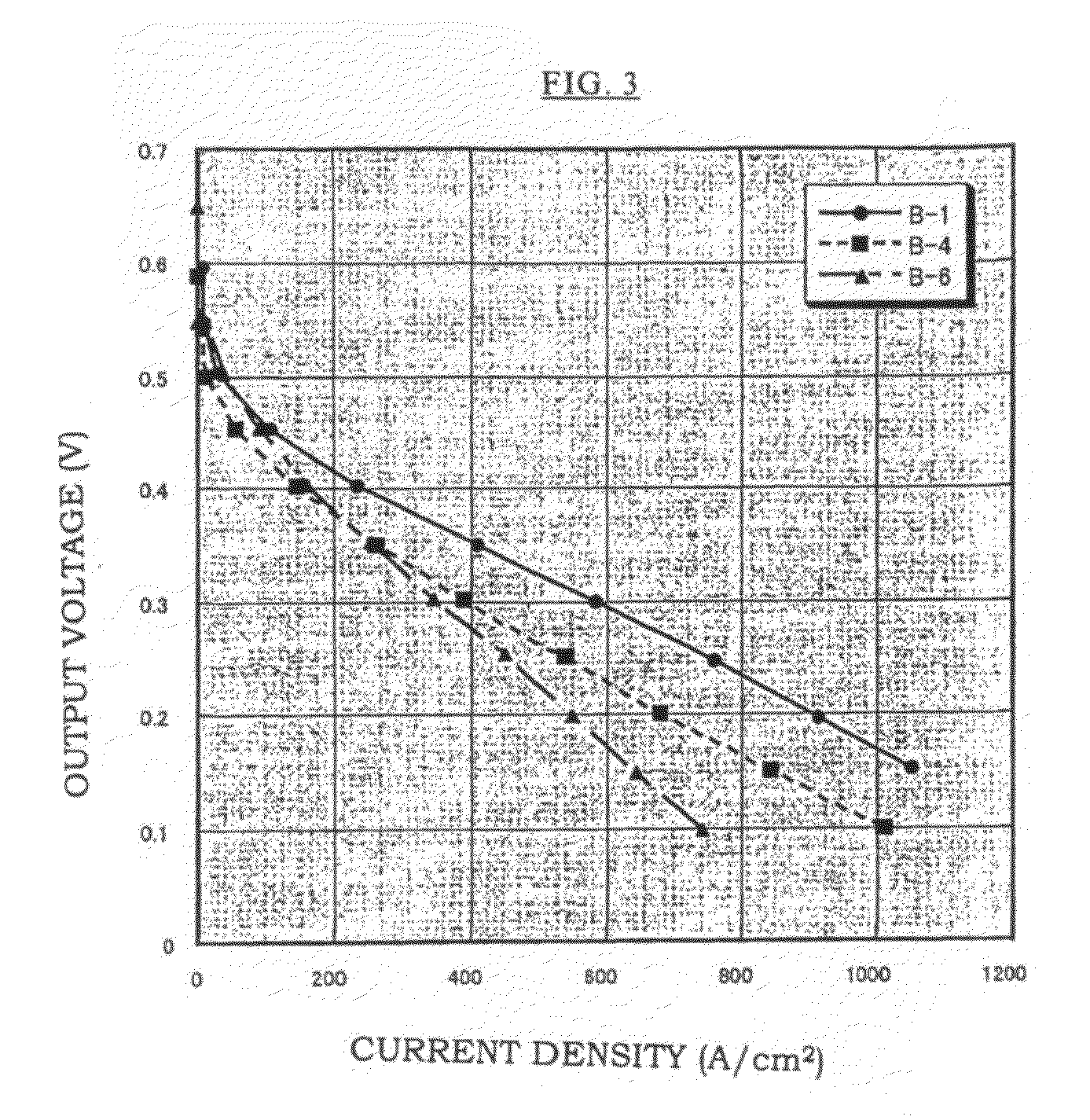Production method of electrolyte membrane, electrolyte membrane and solid polymer fuel cell using same
a production method and technology of electrolyte membrane, applied in the direction of fuel cell details, final product manufacture, chemical/physical processes, etc., can solve the problems of insufficient proton conductivity, weak strength, and insufficient polymerization, and achieve high proton conductivity, high maximum output, and high hydrogen gas impermeability
- Summary
- Abstract
- Description
- Claims
- Application Information
AI Technical Summary
Benefits of technology
Problems solved by technology
Method used
Image
Examples
preparation example 1
[0084]16 parts by weight of a polymer composition consisting of 3% by weight of powder of a ring-opened polymer of norbornen (Norsorex NB manufactured by Atofina in France, weight average molecular weight of 2,000,000 or more), 16% by weight of a thermoplastic elastomer (TPE824 manufactured by Sumitomo Chemical, Co., Ltd.), and 81% by weight of ultra high molecular weight polyethylene of weight average molecular weight 1,500,000 and 84 parts by weight of liquid paraffin were mixed uniformly in a slurry form, and dissolved and kneaded for about 60 minutes using a small kneader at temperature of 160° C. After that, the kneaded matter of these was sandwiched with rolls or metal plates cooled at 0° C., and rapidly cooled in a sheet form.
[0085]The rapidly cooled sheet-formed resin of these was heat-pressed at a temperature of 115° C. until the sheet thickness became 0.5 mm, biaxially drawn to 4.5 times lengthwise and 4.5 times crosswise at the same time at a temperature of 115° C., and a...
example 1
[0086]An aqueous solution was made in which a mixed monomer of 90% by mole of vinylsulfonic acid (hereinafter, abbreviated as “VSA”, manufactured by Asahi Kasei Finechem Co., Ltd., purity 98%) and 10% by mole of a crosslinking agent: methylene bisacrylamide was diluted with water to 80% by weight, and a solution was prepared in which 1% by mole of a water-soluble azo-based initiator (V-50 manufactured by Wako Pure Chemical Industries, Ltd.) was added to 100% by mole of the total amount of VSA and methylene bisacrylamide. The membrane base A-1 was impregnated with this solution, it was irradiated with visible light for 6 minutes, and then heated for 18 hours in an oven of 50° C.
[0087]After that, excess polymers on the surface of the membrane were removed, the membrane was washed sufficiently with distilled water, dried in an oven of 50° C., and Membrane B-1 was obtained. The proton conductivity and the fuel cell performance of this membrane were obtained by measurements. Moreover, a ...
example 2
[0088]An aqueous solution was made in which a mixed monomer of 95% by mole of VSA and 5% by mole of a crosslinking agent: methylene bisacrylamide was diluted with water to 80% by weight, and a solution was prepared in which 1% by mole of a water-soluble azo-based initiator (V-50 manufactured by Wako Pure Chemical Industries, Ltd.) was added to 100% by mole of the total amount of VSA and methylene bisacrylamide.
[0089]The membrane base A-1 was impregnated with this solution, it was irradiated with a visible light for 6 minutes, and then heated for 18 hours in an oven of 50° C. After that, excess polymers on the surface of the membrane were removed, the membrane was washed sufficiently with distilled water, dried in an oven of 50° C., and Membrane B-2 was obtained. The proton conductivity and the fuel cell performance of this membrane were obtained by measurements.
PUM
| Property | Measurement | Unit |
|---|---|---|
| thickness | aaaaa | aaaaa |
| thickness | aaaaa | aaaaa |
| thickness | aaaaa | aaaaa |
Abstract
Description
Claims
Application Information
 Login to View More
Login to View More - R&D
- Intellectual Property
- Life Sciences
- Materials
- Tech Scout
- Unparalleled Data Quality
- Higher Quality Content
- 60% Fewer Hallucinations
Browse by: Latest US Patents, China's latest patents, Technical Efficacy Thesaurus, Application Domain, Technology Topic, Popular Technical Reports.
© 2025 PatSnap. All rights reserved.Legal|Privacy policy|Modern Slavery Act Transparency Statement|Sitemap|About US| Contact US: help@patsnap.com


